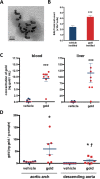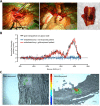Inhaled Nanoparticles Accumulate at Sites of Vascular Disease
- PMID: 28443337
- PMCID: PMC5444047
- DOI: 10.1021/acsnano.6b08551
Inhaled Nanoparticles Accumulate at Sites of Vascular Disease
Erratum in
-
Correction to"Inhaled Nanoparticles Accumulate at Sites of Vascular Disease".ACS Nano. 2017 Oct 24;11(10):10623-10624. doi: 10.1021/acsnano.7b06327. Epub 2017 Oct 4. ACS Nano. 2017. PMID: 28976185 Free PMC article. No abstract available.
Abstract
The development of engineered nanomaterials is growing exponentially, despite concerns over their potential similarities to environmental nanoparticles that are associated with significant cardiorespiratory morbidity and mortality. The mechanisms through which inhalation of nanoparticles could trigger acute cardiovascular events are emerging, but a fundamental unanswered question remains: Do inhaled nanoparticles translocate from the lung in man and directly contribute to the pathogenesis of cardiovascular disease? In complementary clinical and experimental studies, we used gold nanoparticles to evaluate particle translocation, permitting detection by high-resolution inductively coupled mass spectrometry and Raman microscopy. Healthy volunteers were exposed to nanoparticles by acute inhalation, followed by repeated sampling of blood and urine. Gold was detected in the blood and urine within 15 min to 24 h after exposure, and was still present 3 months after exposure. Levels were greater following inhalation of 5 nm (primary diameter) particles compared to 30 nm particles. Studies in mice demonstrated the accumulation in the blood and liver following pulmonary exposure to a broader size range of gold nanoparticles (2-200 nm primary diameter), with translocation markedly greater for particles <10 nm diameter. Gold nanoparticles preferentially accumulated in inflammation-rich vascular lesions of fat-fed apolipoproteinE-deficient mice. Furthermore, following inhalation, gold particles could be detected in surgical specimens of carotid artery disease from patients at risk of stroke. Translocation of inhaled nanoparticles into the systemic circulation and accumulation at sites of vascular inflammation provides a direct mechanism that can explain the link between environmental nanoparticles and cardiovascular disease and has major implications for risk management in the use of engineered nanomaterials.
Keywords: air pollution; atherosclerosis; cardiovascular; gold; nanoparticle; translocation.
Conflict of interest statement
The authors declare no competing financial interest.
Figures






Similar articles
-
New insights into the association of air pollution and kidney diseases by tracing gold nanoparticles with inductively coupled plasma mass spectrometry.Anal Bioanal Chem. 2024 May;416(11):2683-2689. doi: 10.1007/s00216-023-05105-8. Epub 2024 Jan 11. Anal Bioanal Chem. 2024. PMID: 38206347 Free PMC article.
-
Early pulmonary response is critical for extra-pulmonary carbon nanoparticle mediated effects: comparison of inhalation versus intra-arterial infusion exposures in mice.Part Fibre Toxicol. 2017 Jun 20;14(1):19. doi: 10.1186/s12989-017-0200-x. Part Fibre Toxicol. 2017. PMID: 28637465 Free PMC article.
-
Kinetic time courses of inhaled silver nanoparticles in rats.Arch Toxicol. 2022 Feb;96(2):487-498. doi: 10.1007/s00204-021-03191-0. Epub 2021 Nov 17. Arch Toxicol. 2022. PMID: 34787690
-
Toxicokinetics of Nanoparticles Deposited in Lungs Using Occupational Exposure Scenarios.Front Public Health. 2022 Jun 21;10:909247. doi: 10.3389/fpubh.2022.909247. eCollection 2022. Front Public Health. 2022. PMID: 35801236 Free PMC article. Review.
-
Inhaled nanomaterials and the respiratory microbiome: clinical, immunological and toxicological perspectives.Part Fibre Toxicol. 2018 Nov 20;15(1):46. doi: 10.1186/s12989-018-0282-0. Part Fibre Toxicol. 2018. PMID: 30458822 Free PMC article. Review.
Cited by
-
Protocols for isolation and characterization of nanoparticle biomolecular corona complexes.Front Toxicol. 2024 Jul 23;6:1393330. doi: 10.3389/ftox.2024.1393330. eCollection 2024. Front Toxicol. 2024. PMID: 39109300 Free PMC article.
-
Pharmacologic therapies of ARDS: From natural herb to nanomedicine.Front Pharmacol. 2022 Oct 28;13:930593. doi: 10.3389/fphar.2022.930593. eCollection 2022. Front Pharmacol. 2022. PMID: 36386221 Free PMC article. Review.
-
Acute Exposure to Diesel Exhaust Increases Muscle Sympathetic Nerve Activity in Humans.J Am Heart Assoc. 2021 May 18;10(10):e018448. doi: 10.1161/JAHA.120.018448. Epub 2021 May 4. J Am Heart Assoc. 2021. PMID: 33942621 Free PMC article.
-
Reciprocal regulation of NRF2 by autophagy and ubiquitin-proteasome modulates vascular endothelial injury induced by copper oxide nanoparticles.J Nanobiotechnology. 2022 Jun 11;20(1):270. doi: 10.1186/s12951-022-01486-7. J Nanobiotechnology. 2022. PMID: 35690781 Free PMC article.
-
Exposure to Nickel Oxide Nanoparticles Induces Acute and Chronic Inflammatory Responses in Rat Lungs and Perturbs the Lung Microbiome.Int J Environ Res Public Health. 2022 Jan 4;19(1):522. doi: 10.3390/ijerph19010522. Int J Environ Res Public Health. 2022. PMID: 35010784 Free PMC article.
References
-
- Johnston H.; Pojana G.; Zuin S.; Jacobsen N. R.; Møller P.; Loft S.; Semmler-Behnke M.; McGuiness C.; Balharry D.; Marcomini A.; Wallin H.; Kreyling W.; Donaldson K.; Tran L.; Stone V. Engineered nanomaterial risk. Lessons learnt from completed nanotoxicology studies: potential solutions to current and future challenges. Crit. Rev. Toxicol. 2013, 43, 1–20. 10.3109/10408444.2012.738187. - DOI - PubMed
-
- World Health Organization. 7 million premature deaths annually linked to air pollution. http://www.who.int/mediacentre/news/releases/2014/air-pollution/en/. Accessed on March 29, 2017.
Publication types
MeSH terms
Substances
Grants and funding
LinkOut - more resources
Full Text Sources
Other Literature Sources
Medical

